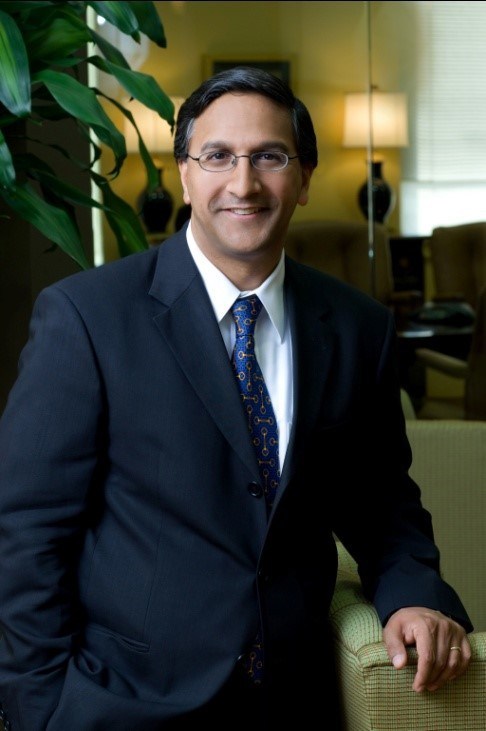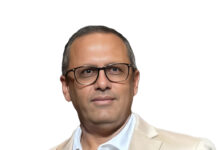BOSTON–The most important lesson venture capitalist and investor Gautam Prakash has learned over the years about investing in India is to be fully aware of the impact that “human emotions” have on investment results.
Mr. Prakash is Founder and CEO of Monsoon Capital, a minority-owned and SEC-registered alternative asset manager specializing in India. Monsoon Capital manages around $300 million in assets across three India-dedicated investment strategies: a fundamental long-biased equity strategy; a systematic CTA trading strategy; and an India real estate private equity strategy. The firm employs 20 professionals across its offices in Washington DC and Mumbai, India.
Prior to launching Monsoon Capital in 2004, Mr. Prakash was an advisor to ChrysCapital, a multi-billion dollar private equity fund based in New Delhi. From 1993-2001, he was a venture capitalist and partner at Bessemer Venture Partners, one of the country’s oldest venture capital firms. As a General Partner, he co-led the health care practice and served on the boards of numerous portfolio companies. Prior to joining BVP, he worked as a management consultant for McKinsey & Company in New York from 1991-1993.
Mr. Prakash was also President and Chairman of The Indus Entrepreneurs (TiE), Boston chapter, and a member of the Board of Trustees of TiE Inc from 2000-2004. TiE is a global organization devoted to the advancement of entrepreneurship, primarily among South Asians.
He holds a BS in Molecular Biophysics and Biochemistry from Yale University with summa cum laude honors and Distinction, in Economics, graduating in 1991.
In an interview with INDIA New England News and its sister publication IndUS Business Journal, Mr. Prakash talks about pros can cons of investing in India.
INDIA NEW ENGLAND NEWS: What is Monsoon India Dynamic Alpha Fund (MIDAS) and how has it performed?
GAUTAM PRAKASH: The Monsoon India Dynamic Alpha Fund, or MIDAS, is Monsoon Capital’s primary strategy for high net worth and institutional investors to access the Indian market. Monsoon Capital, with around $300 million in assets, has a long history of investing in India. After spending a decade-long career in venture capital at Bessemer Venture Partners, I saw an opportunity to invest in the Indian public markets. I started Monsoon Capital in 2004 in Boston while I was president of TiE-Boston and we now have over 14 years of investing experience, 20+ person team, and two headquarters – Mumbai and Washington, DC.
We believe that India provides attractive investment opportunities as the fastest growing major economy in the world. Having invested in this region through multiple market cycles, we developed the MIDAS strategy where we have combined a fundamental long-only stock selection process with an active dynamic hedging model to manage both equity market and currency risks and deliver better risk adjusted returns.
In MIDAS, we focus on identifying quality growth stocks through a process-oriented approach blended with fundamental research. We then dynamically hedge our equity portfolio to manage risk. The hedging overlay is critical and instrumental in addressing India’s volatile market with frequent corrections – for example, last year, India’s mid-caps fell 20% and small caps fell 30% in Dollar terms whereas MIDAS only fell 6%. Protecting and preserving capital during tough market conditions is a key goal of MIDAS, while simultaneously enabling us to fully capture profit from bull markets (such as 2017 when MIDAS was up +32%). In effect, our dynamic approach enables MIDAS to hold higher net exposures in bull markets to take advantage of market rallies, while holding lower net exposures in bear markets as the strategy becomes long/short and currency-hedged in sideways and declining markets.
Since starting the strategy in January 2014, MIDAS has delivered annual net returns of +14.4% as compared to +8.8% for the HFR India Hedge Index and +5.8% for the MSCI India Index, both of which are common benchmarks for investors who analyze the Indian capital markets. Another interesting aspect to MIDAS is that our performance has low correlations to the US stock market which means that investing in MIDAS helps diversify a typical portfolio for a U.S. investor.
INE: How is the investment climate in India today as compared with other emerging and “emerged” markets?
GP: India is clearly a volatile market, driven by both domestic macro factors (such as domestic policy reforms, inflation, politics, greed/fear sentiments, etc) and global macro factors (such as oil prices, fund flows, geopolitical issues, etc). It is, after all, an emerging market. However, we believe the teething issues related to the broad policy reforms that PM Modi has passed are largely behind us, evidenced by accelerating corporate earnings in recent quarters. For example, our expected earnings growth rate in the MIDAS portfolio this year is +31%, which is the highest we have ever had in the fund. Also, the recent reforms have brought stability to domestic macros (particularly lower Inflation and a smaller fiscal deficit). So, we think India has some tremendous tailwinds going for it, with the world’s fastest GDP growth helping to power accelerating earnings growth across the board, especially in mid-sized companies. We think the climate in India right now is quite attractive relative to other emerging markets and even developed markets. For example, India is witnessing declining interest rates and declining inflation while still clocking 6-7% real GDP growth rates, largely due to structural reforms in last 5 years (normally high GDP growth rates result in rising inflation and, eventually, in rising interest rates which then slow the economy down).
India also has made major strides in reducing corruption, increasing transparency in markets, cleaning up specific sectors such as real estate and, most importantly, streamlining taxation to both increase compliance and increase efficiency. For example, the Goods-and-Services Tax (GST) which was rolled out 18 months ago, effectively converts India from 29 distinct states into a single market, similar to what happened in Europe with the creation of the European Union. Another example is the Insolvency and Bankruptcy Code (IBC) which reduces the ability for Indian promoters to shortchange minority shareholders and forces poorly-performing companies to clean up their act or risk liquidation. Finally, we are seeing strong growth in domestic fund flows in the stock market as more and more local investors allocate to equities versus traditional investments such as gold and real estate – in fact, these local fund flows are up over 10X in the past 3-4 years.
INE: Which Indian sectors would continue to grow?
GP: In our view, the Indian consumer is the single most important driver to India’s growth story and is an area of strong emphasis for us in the MIDAS fund. India’s fast-growing and young demographic, in both urban and rural areas, are increasing their spending on goods and services, powering attractive earnings growth and cash flows amongst consumer-facing business such as private retail banks, automotive, 2-wheelers, home mortgages, home product materials and consumer discretionary items (like air conditioners, washing machines and refrigerators).
Of course, we believe in portfolio diversification, so we also hold positions in other sectors such as pharmaceuticals and IT. But companies that sell to the Indian consumer form the most significant part of our MIDAS fund.
INE: How will global economy impact India?
GP: India is not really an export-oriented country, unlike China. Outside of pharmaceutical and information technology, India generally does not manufacture products or services for the global economy. So, it is somewhat insulated from the global economy in terms of macro events like trade wars. Having said this, certainly a global recession would adversely impact India as it would lead to lower fund flows from global investors which typically leads to a market correction (as we saw in the last few months of 2018). No economy is truly de-linked from the rest of the world, but relative to other large emerging economies such as China or Russia, we think India is better insulated from global vicissitudes.
INE: Given the volatility of the region and political climate in India, some say investing in the Indian equity markets is still risky. Do you agree and why?
GP: All types of investments involve some degree of risk – the real question is whether you are able to assess those risks and address them, one-by-one, to reduce the overall risk profile of your portfolio. For sure, India is a noisy democracy and is about to embark on the world’s largest exercise in democracy with potentially over 900 million people going to the polls before mid-May to elect their next government. That process is always fraught with risk and uncertainty, but our view is that regardless of who is elected as India’s next Prime Minister, the economy should hold up well, driven by strong demographics, urbanization and recent reforms. In fact, data shows that the Indian stock market performs quite well in the immediate months before, during and after national elections, so we think 2019 could shape up to be a strong year for Indian equities.
In terms of the upcoming elections in India, the latest opinion polls by most agencies point to the BJP-led NDA Party emerging as the biggest alliance, falling short of the 272-seat majority mark by only 10-15 seats which should be an easy gap for the NDA to fill with support of regional parties and independents. Pre-February, this shortfall was pegged at 40-50 seats which would have been more challenging for the NDA Party to overcome. So, the likely outcome is that Mr. Narendra Modi will be re-elected as Prime Minister (PM) for another 5-year term. Even if he is not re-elected and we end up with a ‘third front’ government supported by the Congress Party, we think the economy should still be fine, but populism and lack of fiscal discipline would likely increase.
INE: Given your many years of experience investing in India, what is the most important lesson you have learned along the way?
GP: The most important lesson we’ve learned over the years is to be fully aware of the impact that human emotions have on investment results. Every day we come to work, we are making 3 key portfolio decisions: 1) what stock to buy; 2) how to size that stock in the portfolio; and 3) when to sell that stock. On most days, we are not making any changes to our portfolio but are still effectively making these 3 decisions constantly (since doing nothing is still an active decision). So, the impact of cognitive biases – such as recency effect, confirmation bias and gambler’s fallacy – can have a significant effect on optimally managing an investment portfolio.
We address this risk by following BOTH a fundamental rules-based investment process for stock selection and position sizing and a quantitative-based set of rules for managing risk. This involves systematically reducing our equity exposure during market corrections as well as reducing our currency exposure when the Indian Rupee is depreciating. Hence, our sole purpose in MIDAS is to target better risk-adjusted returns for our investors. We advise investors to heed the famous words from the luminary investor Benjamin Graham: “Successful investing is about managing risk and not avoiding it”.








